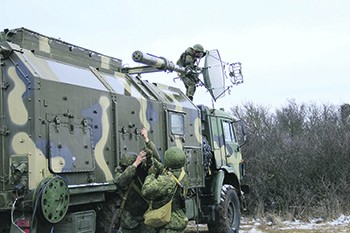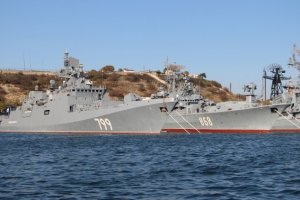
Signalers at work. Photo from www.mil.ru
Hezbollah has established an efficient and redundant communications system, starting with wired communication and ending with personal beepers. Despite numerous attacks, part of the system existed until the end of hostilities and made it possible to control missile units, armed with "Katyushas".
Georgian-Ossetian war. Georgia
The fighting was affected by the complete lack of communication in 41, 42 and 43rd battalions. In particular, in the 43rd battalion before lunch 8 August, there was no information about, what is happening in Tskhinvali and Gori. Due to poor logistics, lack of water flasks 42nd motorized infantry battalion was hiding from the intense heat (+40 FROM) in the oak grove, where it was bombed by Russian attack aircraft. The battalion had 22 killed, many wounded were left in place. The commanders fled the battlefield in cars, taking with them only those soldiers, who were able to get into cars, and those who strayed from the transport were abandoned.
Russia at war 08.08.08
In the mountains, the paratroopers had big communication problems.. The almost complete lack of communication forced General Borisov (commander of the grouping of airborne troops in South Ossetia and Georgia in the South Ossetian direction) use "courier mail".
Officer of the Operations Department of the Headquarters of the Airborne Forces in a helicopter, flying at low altitude, found paratroopers on the march, landed and set or specified the task. A serious miscalculation was the complete dependence of all means of destruction - aircraft, helicopters, ships, tanks, artillery, RSZO, precision munitions, cruise missiles - from navigation support. The Russian army needs to deploy its own satellite constellation, capable of providing troops with navigation data. There is a need to put into operation a new navigation system for operational support, which is currently in its infancy.
APU in the civil war in Ukraine
There was an acute shortage of modern means of operational secure communications in the Armed Forces of Ukraine. Most of the exchange of operational information was carried out through mobile phones. The switched on phones of the overwhelming majority of soldiers in the ATO zone allowed the enemy to very accurately determine the number of Ukrainian troops, up to a person. With a high load of existing communication centers, this allowed the militia to quickly find the direction of the most powerful transmitters, sources of intense radio traffic. Calculating the location of army headquarters by triangulation is easy: having taken the direction of the radio transmitter, by the power and intensity of work you determine its significance and the level of headquarters, which he serves.
Ukrainian units are equipped with digital mobile stations and leave mobile phones at the base, while the commanders pay insufficient attention to the discipline of radio communications in the unit. Even the most secure radio, if you use it while driving, unmasks troops. Any broadcast, especially in the border regions with the Russian Federation, were taken by the enemy, and in these places the Russians launched artillery strikes. To ensure the surprise of the attack during the redeployment of troops, it is advisable to stop radio contact with any correspondents until the signal is given. Chatter on the radio and by telephone helps enemy radio intelligence, faster than any spies, to draw up a complete map of the situation and disposition of troops and predict their immediate intentions.. When moving in close proximity to the enemy, one must not forget, that radio communication is an unmasking factor, it is a means of control in combat. The use of radio communications to control the movement of units, for the transmission of secondary information is impractical in areas, where there is a high probability of direct fire contact with the enemy.

Ukrainian admiral complained to strengthen the Russian Navy's combat potential
The lack of opportunities for laying secure fiber-optic communication lines complicates the implementation of combat missions. Fiber optic cable can significantly reduce radio traffic or completely eliminate it, which increases the secrecy of actions.
The Ukrainian security forces do not have radio stations of the company-battalion link, allowing company commanders to maintain contact with battalion commanders and brigade commanders. On the well-known video of the defeat of the checkpoint near Volnovakha, commanders communicate with higher headquarters by cell phones. Calls from relatives have become a way of informing the command about the course of hostilities.. The Ukrainian media, eg, after the defeat 11 July, units of the 24th mechanized brigade reported that, that the ATO headquarters learned about what happened from the wife of a military man. The surviving soldier contacted his wife by cell, who called the command and told about, what happened to the part, where her husband served. And this is far from the only case..
Donbass militia
At first, the militia detachments provided themselves with communications, capturing trophies, stored in warehouses and bases of the SBU, in police departments, military units. Usually, these were outdated samples of radio stations of the Soviet period. Before the start of the active phase of hostilities, this suited the leaders and self-defense fighters quite well.. With the escalation of the conflict, the lack of portable communications has become more acute. The enemy began to use electronic warfare (direction finding, the radio broadcast). Going on combat missions with mobile phones instead of military radio stations has become dangerous. As the participants of the events said, maximum through 20 minutes after the start of a conversation on a mobile phone, a fairly accurate shelling of the subscriber's location began from the Ukrainian side.
In 2015–2016, the way volunteer teams were recruited. Some of them have sponsors - financially secure persons, who took over the equipment and equipment. New problems have arisen, eg, use even in one unit of different types of communications. Assistant chief of staff for intelligence of one of the volunteer battalions (callsign "Storm") says: “Our sponsor forked out for 16 walkie-talkies "Kenwood" - just the number of fighters in my group. But, making such a present, did not take into account a number of specific features of the reconnaissance unit. At first, they were different models: 12 civil Kenwood TK-UVF8 MAX 2013 year of manufacture and 4 pieces of even older TN-22. Secondly, buying radio stations, the sponsor did not take care of the headset and spare batteries for them. As a result from 16 pieces really worked only 8. Rest, changing each other, were on charge. We took them in raids reluctantly: when turned on, the radio display at the most inopportune moment lit up brightly, unmasking the owner. I also had to glue or paint over the display, and the battery charge level light - it burns too brightly. Often there was a failure of communication channels on models with touch control when accidentally touched ".
Lack of specialists played a role, communications instructors in militia units. Some fighters were never able to master all the functions of radio stations, remaining only primitive users. Many civilian models did not match their performance characteristics. During the 270-kilometer march of a column of armored vehicles, an accident occurred with the participation of an infantry fighting vehicle. Distance to head patrol, where was the senior, did not exceed ten kilometers, while using Kenwood for communication, in the characteristics of which it is declared to maintain reliable communication in open areas at three times the distance, was not possible. The situation was saved by the backup Motorola GP-300 with a manual toggle switch and channel search, the column managed to get away from the raid of Ukrainian artillery in time.
According to the head of the communications center and the commander of the communications company, the choice of Kenwood radio stations for deliveries to volunteer fighters is a mistake. The models of this company in their divisions were abandoned more than ten years ago due to not only their unreliability and low performance characteristics, but also the sad experience of the recent Gulf Wars. Programmers came to the conclusion, that these devices, made in the USA, may well be tapped by foreign intelligence services. That is why with 2005 of the year, radio stations of domestic production "Erika" began to enter the troops, over time, reaching the characteristics of "Motorola", which, by the way, still remains in service in the Russian army and in the Ministry of Internal Affairs of the Russian Federation.

LAD complies entered Russian truce despite the provocations of Ankara to Tripoli
Near East
In the Syrian campaign, there was an opportunity to demonstrate Russian weapons in action, satellite communications and the GLONASS navigation system - their high accuracy and reliability. This demonstration is aimed primarily at potential customers in the largest and growing Su-34 market., which perform the tasks of delivering strikes with high-precision aircraft weapons (GLONASS-corrected KAB-500S bombs) for especially important and difficult purposes.
Crimean passage of ships of the MVS of Ukraine
Negotiations between Russian border guards and naval officers, which were voiced by Kiev the day after the detention of Ukrainian ships in the territorial waters of the Russian Federation in the Kerch Strait, called, to put it mildly, perplexity. First radio station, which not only caught up, but in some respects surpassed foreign samples, became the radio station R-187P1 "Azart", related to 6th generation communication systems. It can work in repeater mode, shows the commander the location of each subordinate. The radio station receives a signal from the satellite, television signal, waves of all operational services. The radio transmits data at a speed 7,5 kilobit per second, It can be used to call any mobile. It is impossible to detect "Excitement" - the frequencies change every 45 microsecond. Besides, the device is highly resistant to electronic jamming and transmits information in digital form. AND, by the way, the compatibility of secret communications between the FSB and the Ministry of Defense is established only at the level of command and headquarters at different levels. That is, only the generals of these departments can call each other, and the commanders of the border guards are forced to communicate with their colleagues from the Navy through open communication.
findings
1. The armed conflict in South Ossetia once again confirmed the relevance of creating interspecific operational-strategic formations in Russia. Today it is impossible to fight successfully, if the main parameters of the communications systems of the Ground Forces, SCC, Navy don't match. The leadership of the Armed Forces of the Russian Federation needs to immediately begin solving the problems of interoperability of marine, land and air means of communication and control, bring them to the main parameters, allowing the use of strategic, operational, tactical ACCS.
2. Existing communication and control systems need to be converted from analog to digital. After the transition to digital technologies, it will be necessary to start developing "operational-tactical centers for organizing fire", but make adjustments and reactions to information in the management program, received from ground reconnaissance, units and units of the Ground Forces.
3. There was a need to develop requirements for the navigation support system in Russian military science, which is currently in its infancy. Unified digital model of the country's territory, and then the entire globe could become the basis of the state geoinformation fund. Proposals for its formation were formulated and substantiated at the end of the 20th century..
4. It is necessary to transfer the Unified electronic cartographic basis (EECO) as a base for geoinformation support from Rosreestr (traditional cartography and modern geoinformatics seem to be secondary tasks) military department for the very real creation of the Unified State Spatial Model (EGPM).
5. Russian government, The Ministry of Defense of the Russian Federation needs to create a Federal Operator of Spatial Data (FOPD). Its main function should be to collect, generalization of geodata, received from various departments, and prompt provision of them to consumers. However, the first task of the FOPD is to develop the necessary legal acts, organizational-administrative and normative-technical documentation, regulating the relationship of all providers and consumers of geodata.
6. Tasks for the development of elements of domestic laser scanning technology should be prepared as a matter of urgency, including a universal module of a pulsed laser scanner for use both in a stationary, as well as mobile, with characteristics: volume up to 2 liters, weight up to 2 kg, power consumption 100 W, clock frequency 400-1000 kHz; normative documentation for digital terrain models, including object directories, rules for their digital description, requirements for accuracy, taking into account the specifics of individual industries; a complex of applied software for processing laser scanning data and related information, formation of object models taking into account industry specifics; a complex of applied software for working with digital models in the management of individual industries (including for automated control systems) and in command and control processes.
7. When conducting an antiamphibious operation at sea, have means of secret communications between naval ships, border boats for the protection of the water area, by the FSB, supporting aviation and units of coastal troops.











